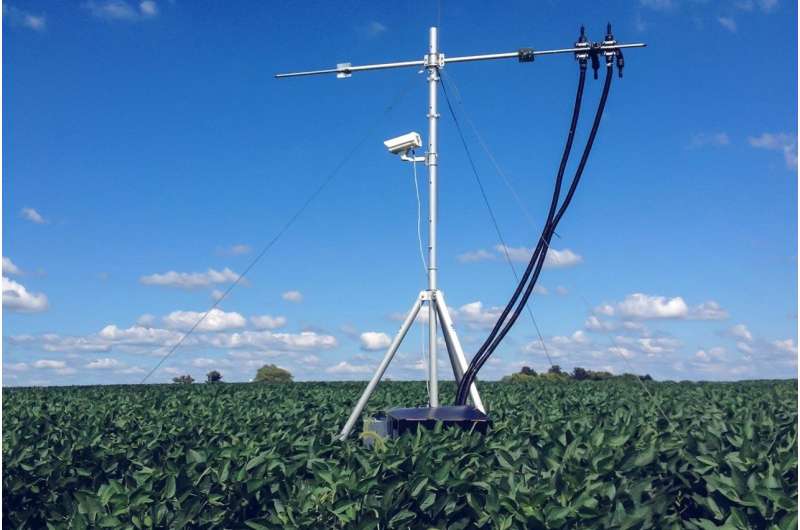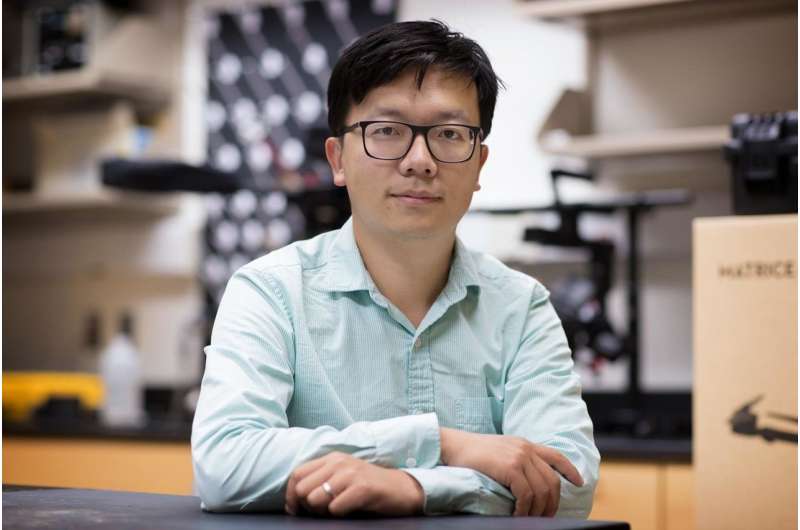A view from 50,000 feet (and higher)—scientists seek new ways to monitor crop health

A University of Virginia environmental scientist and colleagues at the University of Illinois are working to evaluate crop conditions and forecast crop yields in real time.
Eventually the researchers hope to use their innovative technique – remotely measuring a byproduct of photosynthesis – to forecast crop yields, regionally and worldwide, using sensors aboard satellites.
Currently they are doing this closer to ground level on a mini scale in the midwestern United States. They have set up a monitoring site above a soybean field in Illinois, where they measure an invisible-to-the-human-eye array of light emitted by the crops. This light can reveal the plants' photosynthetic performance throughout the growing season, an indicator of growth rates and productivity that allows the scientists to predict crop yields.
The results of their study were published recently in the Journal of Geophysical Research – Biogeosciences. The researchers used sun-induced fluorescence, or SIF, data to determine in real time how soybeans respond to fluctuating light levels and environmental stresses across a full field season.
The technique is also being deployed to other crop types in Nebraska.
"By applying this technology to different regions, we can ensure the efficacy of this tool in countless growing conditions, for a myriad of plants," said UVA terrestrial ecologist Xi Yang, an assistant professor of environmental sciences. Yang is the designer of the study's SIF monitoring system, and is endeavoring to apply the technique to a range of vegetation, from crops to grasslands to forests.

Photosynthesis is the process whereby plants convert light energy into sugars and other carbohydrates for new growth. One to 2 percent of the plant's absorbed light energy is emitted as fluorescent light that is proportional to the rate of photosynthesis, a growth and health indicator.
The researchers are capturing these fluorescent emissions using a spectroscopic sensor system, designed by Yang, that detects fluctuations in photosynthesis over the length of a growing season. The continuous study is designed to better understand the relationship between absorbed light and emitted fluorescent light – and the rate of photosynthesis. Yang and his colleagues are working to understand if proportional relations are consistent across various ecosystems, particularly between crops and wild and managed ecosystems.
"The groundbreaking SIF system that Xi [Yang] developed paves the way to use satellite-based monitoring of photosynthesis for crop yield prediction and management," said Kaiyu Guan, an assistant professor at the University of Illinois and the principal investigator for the project, which is funded by NASA. "Using SIF, we can provide accurate predictions of crop yield and forest productivity over large spatial scales."
SIF can also be used to detect plant stress during drought, heat stress and insect attack. Yang's lab is developing a drone-based remote sensing system that measures sun-induced flourescence and canopy temperature.
"In the future, this approach can help us monitor the health of both forests and crops in real time," Yang said.
Earth-observing satellites that measure carbon dioxide and ozone in the atmosphere inadvertently also detect fluorescence signals from vegetation. Yang believes that data can be readily captured and utilized to monitor plant photosynthesis globally, to access ecosystem and agricultural health and anticipate changes.
Such data would be useful to farmers and foresters for planning, watering, fertilizing and harvesting, he said.
Provided by University of Virginia




















